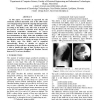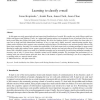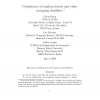Publication
In this paper we propose a novel approach based on multi-stage random forests to address problems faced by
traditional vessel segmentation algorithms on account of image artifacts...
ICCV
2011
IEEE
13 years 6 months ago
2011
IEEE
This paper introduces a new formulation for discrete image labeling tasks, the Decision Tree Field (DTF), that combines and generalizes random forests and conditional random fiel...
PR
2011
13 years 9 months ago
2011
In this paper, we describe an approach for the automatic medical annotation task of the 2008 CLEF cross-language image retrieval campaign (ImageCLEF). The data comprise 12076 full...
ICIC
2009
Springer
14 years 4 months ago
2009
Springer
In this paper we present a study on the Random Forest (RF) family of ensemble methods. From our point of view, a "classical" RF induction process presents two main drawba...
NDT
2010
14 years 5 months ago
2010
Web directory hierarchy is critical to serve user’s search request. Creating and maintaining such directories without human experts involvement requires good classification of we...
ISCI
2007
14 years 6 months ago
2007
In this paper we study supervised and semi-supervised classification of e-mails. We consider two tasks: filing e-mails into folders and spam e-mail filtering. Firstly, in a sup...
JMLR
2006
14 years 6 months ago
2006
Random forests were introduced as a machine learning tool in Breiman (2001) and have since proven to be very popular and powerful for high-dimensional regression and classificatio...
JMLR
2008
14 years 6 months ago
2008
In the last years of his life, Leo Breiman promoted random forests for use in classification. He suggested using averaging as a means The second author's research was sponso...
BMCBI
2010
14 years 7 months ago
2010
Background: Data generated using `omics' technologies are characterized by high dimensionality, where the number of features measured per subject vastly exceeds the number of...
DAGM
2010
Springer
14 years 8 months ago
2010
Springer
Abstract. A successful approach to tracking is to on-line learn discriminative classifiers for the target objects. Although these trackingby-detection approaches are usually fast a...



